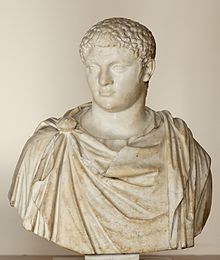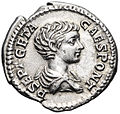Publius Septimius Geta
From Wikipedia, the free encyclopedia
For other people of the same name, see Publius Septimius Geta (disambiguation).
| This article needs additional citations for verification. (December 2010) |
| Geta | |||||
|---|---|---|---|---|---|
 |
|||||
| Joint 22nd Emperor of the Roman Empire (with Caracalla) | |||||
| Reign | 209 – December 211 | ||||
| Predecessor | Septimius Severus | ||||
| Successor | Caracalla | ||||
| Co-emperors | Severus (209–Feb.211) Caracalla (209–Dec.211) |
||||
|
|||||
| Dynasty | Severan | ||||
| Father | Septimius Severus | ||||
| Mother | Julia Domna | ||||
| Born | 7 March 189 Rome |
||||
| Died | 19 December 211 (aged 22) | ||||
Contents
Early life
Geta was the younger son of Septimius Severus by his second wife Julia Domna. Geta was born in Rome, at a time when his father was only a provincial governor at the service of Emperor Commodus.Conflicts between Geta and Caracalla were constant and often required
the mediation of their mother. To appease his younger son, Septimius
Severus gave Geta the title of Augustus in 209.
During the campaign against the Britons
in the early 3rd century CE, imperial propaganda promoted the image of a
happy family that shared the responsibilities of rule. Septimius
Severus entrusted Julia Domna with the role of counsellor, Caracalla
acted as the emperor's second in command, and administrative and
bureaucratic duties were Geta's responsibility. In reality, however, the
rivalry and antipathy between the brothers did not abate.
Joint Emperor
When Septimius Severus died in Eboracum in early 211, Caracalla and Geta were proclaimed joint emperors and returned to Rome.Their joint rule was a failure. Later sources speculated that the
brothers wished to split the empire in two halves. By the end of 211,
the situation had become unbearable. Caracalla tried unsuccessfully to
murder Geta during the festival of Saturnalia.
Finally, on the 19th of December, Caracalla had his mother arrange a
peace meeting with his brother in his mother's apartments, and then had
him murdered in her arms by centurions.
| Roman imperial dynasties | |||
| Severan dynasty | |||
| Severan dynasty - tondo.png The Severan Tondo |
|||
| Chronology | |||
| Septimius Severus | 193–198 | ||
| —with Caracalla | 198–209 | ||
| —with Caracalla and Geta | 209–211 | ||
| Caracalla and Geta | 211–211 | ||
| Caracalla | 211–217 | ||
| Interlude: Macrinus | 217–218 | ||
| Elagabalus | 218–222 | ||
| Alexander Severus | 222–235 | ||
| Dynasty | |||
| Severan dynasty family tree All biographies |
|||
| Succession | |||
| Preceded by Year of the Five Emperors |
Followed by Crisis of the Third Century |
||
from all inscriptions. The now sole emperor also took the opportunity
to get rid of his political enemies, on grounds of conspiracy. Cassius Dio stated that around 20,000 men and women were killed or proscribed during this time.[2]
Portrait
Very few marble portraits attributable to Geta survive to date, presumably due to the very thorough damnatio memoriaewhich resulted in the erasing of his images. However Roman coins with
his image are plentiful, and can reflect how his father Septimius
Severus and later Geta himself wanted him to be seen by the Roman people
(and especially the Roman military).
Images of Geta and his older brother Caracalla cannot be well
distinguished until the death of the father. Both sons were supposed to
be presented as equally suitable heirs to the throne, showing thus more
"depth" to the dynasty.
On his coins Caracalla, who became Augustus in 197, was shown with a
wreath of laurels, while Geta remained bareheaded until he himself
became Augustus in 209.[3]
Between 209 and their father's death in February 211, both brothers
were shown as equally mature young men with a short full beard, ready to
take over the empire. Between the death of Septimus Severus and the
assassination of Geta, Caracalla's portraits did not change, while Geta
was depicted with a long beard with hanging hairs much like his father, a
strong indication of Geta's efforts to be seen as the "true" successor
of his father.[4]
Gallery
The Severan Tondo,
a painting of Septimius Severus with Julia Domna, Caracalla, and Geta,
whose face is smeared out, probably because of the damnatio memoriae put
against him by Caracalla.
See also
Notes
- Andreas
Pangerl: Porträttypen des Caracalla und des Geta auf Römischen
Reichsprägungen - Definition eines neuen Caesartyps des Caracalla und
eines neuen Augustustyps des Geta; Archäologisches Korrespondenzblatt
des RGZM Mainz 43, 2013, 1, 99–116
References
- Dio Cassius lxxvii; Herodian iv. I.
External links
| Wikimedia Commons has media related to Publius Septimius Geta. |
- Life of Geta (Historia Augusta at LacusCurtius: Latin text and English translation)
Publius Septimius Geta Born: 7 March 189 Died: 26 December 211 |
||
| Regnal titles | ||
|---|---|---|
| Preceded by Septimius Severus |
Roman Emperor 209–211 With: Septimius Severus and Caracalla |
Succeeded by Caracalla |
| Political offices | ||
| Preceded by Lucius Fabius Cilo, Marcus Annius Flavius Libo |
Consul of the Roman Empire 205 with Caracalla |
Succeeded by Marcus Nummius Umbrius Primus Senecio Albinus, Lucius Fulvius Gavius Numisius Petronius Aemilianus |
| Preceded by Lucius Annius Maximus, Gaius Septimius Severus Aper |
Consul of the Roman Empire 208 with Caracalla |
Succeeded by Lucius Aurelius Commodus Pompeianus, Quintus Hedius Lollianus Plautius Avitus |
| Legendary titles | ||
| Vacant Interregnum Title last held by Lucius |
King of Britain | Succeeded by Bassianus |
|
||
|
Categories:
- 189 births
- 211 deaths
- Carthaginians
- Characters in works by Geoffrey of Monmouth
- 3rd-century Roman emperors
- Imperial Roman consuls
- Severan dynasty
- Septimii
- People from Rome
- British traditional history
- Murdered Roman emperors
- Deified Roman emperors
- Roman emperors to suffer posthumous denigration or damnatio memoriae
- People from Homs
- Royal Family of Emesa
- Burials at the Castel Sant'Angelo
Pangerl: Porträttypen des Caracalla und des Geta auf Römischen
Reichsprägungen - Definition eines neuen Caesartyps des Caracalla und
eines neuen Augustustyps des Geta; Archäologisches Korrespondenzblatt
des RGZM Mainz 43, 2013, 1, 99–116



No hay comentarios:
Publicar un comentario